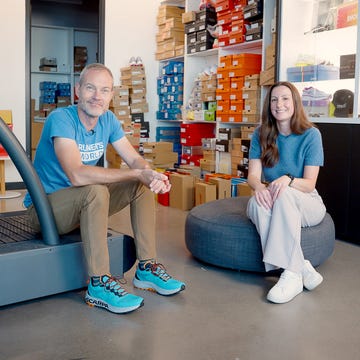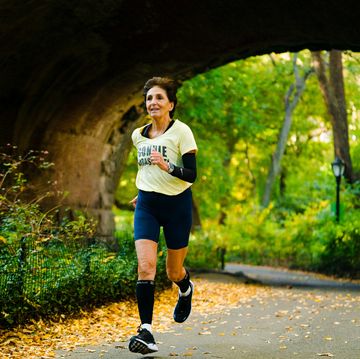For shoe brands, the biggest prize in NCAA distance running this year is Parker Valby of the University of Florida.
Valby, 21, has been dominant in the college ranks over the past year, winning four national titles by large margins and breaking two collegiate records. During the indoor season, she twice broke the NCAA 5,000-meter record that had stood for 15 years. In April, she smashed the collegiate 10,000 meter record in her debut at the distance, running 30:50.43, which put her 11th on the U.S. all-time list.
She is set to run the 5,000 and 10,000 meters at the NCAA outdoor championships. The women’s competition begins June 6 at Hayward Field in Eugene, Oregon.
In June 2023, Valby signed a name-image-likeness (NIL) deal with Nike. NIL deals end when the athlete leaves college and turns pro. To this point, distance runners in the NCAA have tended to sign their professional shoe contracts with the same company that has signed them to an NIL deal.
For example, Katelyn Tuohy of North Carolina State University was the first collegiate distance runner to ink a substantial NIL deal with a shoe brand, Adidas, and when she turned pro last fall, she went with Adidas. Charles Hicks of Stanford signed an NIL deal with Nike and later joined Nike’s Bowerman Track Club.
Valby, however, could break that mold, as large brands with deep pockets, including Puma and New Balance, are making a concerted push for her, sources told Runner’s World. It is unclear whether other companies, like Adidas, Asics, Brooks, On, and Under Armour, are also making serious efforts to sign her.
Valby is thought to be commanding a base annual payment of $650,000 to $800,000 per year. Although agent Tom Ratcliffe negotiated Valby’s NIL deal for her, Valby’s father, Kyle Valby, is said to be negotiating her pro contract. Agents in running typically take a 15 percent fee from an athlete’s sponsorship and prize money, although occasionally athletes negotiate lower fees. Efforts by Runner’s World to reach Kyle Valby were not successful.
Calls, texts, Zooms, trips
Every year, college athletes and shoe companies engage in an elaborate recruiting ritual, which resembles that of college coaches recruiting athletes out of high school. And with at least nine companies involved in distance running and pursuing recent college athletes for marketing, it’s a good time for athletes coming out of college to score lucrative deals.
Representatives from brands reach out to college coaches, set up Zoom meetings with athletes, and invite them to meet with their training groups.
Ben Rosario, the executive director of the Hoka-sponsored NAZ Elite team in Flagstaff, Arizona, told Runner’s World that his group invites athletes they’re interested in for a two-day visit, which involves the runners watching a workout, going for a run, and having a meal at a restaurant or a cookout (often at the home of Stephanie and Ben Bruce).
Recruiting visits like these take place all over the country and can begin the summer before an athlete’s senior year and go until the weeks before the NCAA outdoor championships.
NIL, Rosario said, has been a strategy brands use to jump out to a lead in the race to sign college talents.
“Trying to get in so early, when they’re freshmen and sophomores and juniors, hoping that when the NIL deal is up that they’ll go with their brand. That’s obviously what it is,” Rosario said of brands’ tactics. “Because they’re not really using their name, image, and likeness; they’re just paying them and calling it an NIL.”
NIL deals are supposed to be in exchange for marketing campaigns, but few shoe companies are involving their NIL athletes in extensive marketing. For example, in the year before she went pro, Tuohy made only three posts on Instagram that were explicitly about Adidas.
“They’re just paying them, and why is that?” Rosario said. “I think it’s because they want to get their foot in the door for what might come in the future. I think it’s in its infancy, we have to see how it plays out.”
In addition to Valby, top recruits coming out of the NCAA this year include steeplechaser Olivia Markezich of Notre Dame (who has an NIL deal with On), 800-meter runner Michaela Rose of Louisiana State University (Adidas), Maia Ramsden of Harvard (On), Nico Young of Northern Arizona University (Adidas), and several University of Washington milers, including Joe Waskom (Adidas).
But Valby is clearly the big prize and something of a wildcard. Because of injuries early in her collegiate career, she relies heavily on cross training and runs a lot less than many athletes. Some industry insiders believe she has tremendous upside if she could do more running mileage, but it’s unclear which teams would be willing to accommodate her unconventional training.
Nike’s choices for distance runners, Bowerman Track Club and Union Athletics Club, aren’t seen as ideal fits for Valby. Bowerman, under coach Jerry Schumacher, has been a one-size-fits-all program and has seen an exodus of its top talent since the team moved from Portland to Eugene, although Valby’s former college coach, Chris Solinsky, is now a coach with the group.
Pete Julian’s group, the Union Athletics Club, has more of a middle-distance focus, with Olympic medalist Raevyn Rogers in the 800 meters and U.S. champion Sinclaire Johnson in the 1500 meters.
Puma has a growing training group in North Carolina under Amy and Alistair Cragg, which includes Olympic Marathon Trials champion and 10,000-meter runner Fiona O’Keeffe. New Balance Boston, under coach Mark Coogan, has Olympians Elle St. Pierre and Heather MacLean, among others.
Some athletes are still weighing their pro options and will continue to do so up until the start of the Olympic Trials, on June 21. Others in the NCAA have likely already decided where they’ll be training and which brand they will sign with, but they will keep it under wraps until after their final meet, the NCAA championships, in their college uniform.
Rosario hopes that when the dust settles and athletes begin to announce their decisions, he’ll have a couple of new names on his roster, even if they’re runners who had NIL deals with companies other than Hoka.
“I would certainly encourage anyone who signs a temporary NIL that only lasts through the end of your college years, to use that for what it’s for,” he said. “The money is great and that is wonderful, and then it’s over. And that means that the contract is completely over, and you owe that company nothing. And you move on to make your decision with a clear and open mind.”

Sarah Lorge Butler is a writer and editor living in Eugene, Oregon, and her stories about the sport, its trends, and fascinating individuals have appeared in Runner’s World since 2005. She is the author of two popular fitness books, Run Your Butt Off! and Walk Your Butt Off!













